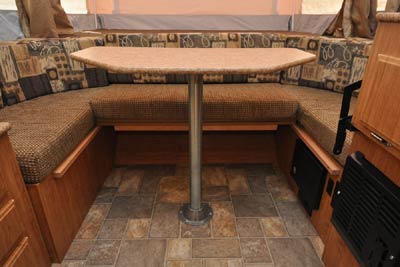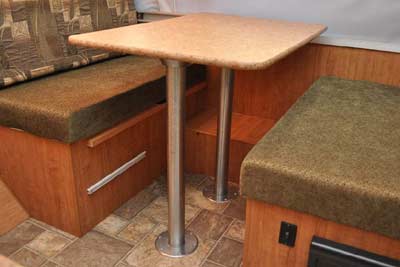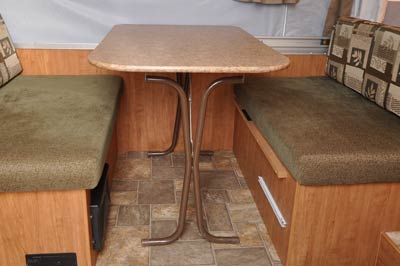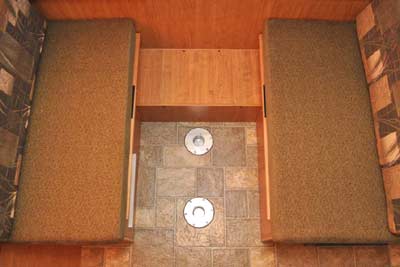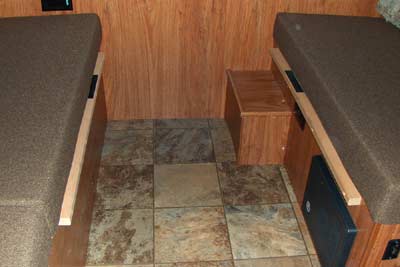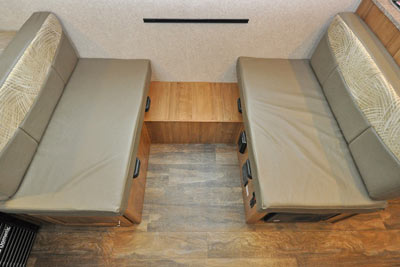Not All Dinettes Are Created Equal
The size, placement, and shape of various dinettes affect their functionality and comfort. This article discusses the pros and cons of different dinettes to help you decide which one suits your needs best.
Size
Dinette sizes vary from model to model. Currently, the smallest dinette in a Flagstaff pop-up is 34" x 64" and the largest is 50 " x 80". Technically both of these dinettes are supposed to seat four people and sleep two people even though the small dinette would barely sleep two small children (let alone adults) while the large dinette could nearly seat six people.
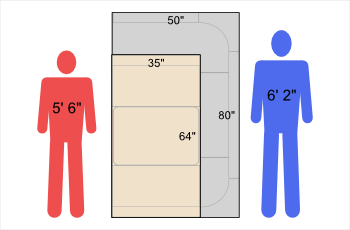
"So I shouldn't buy a camper with a 64" dinette?" Not necessarily--just make sure you sit at a 64" dinette table first to make sure you find it comfortable. For some people the 64" dinette is too small: the seat cushion doesn't support their legs fully and the dinette table is too close to their torso for comfort; for others an 80" dinette may be too large and leaves the table too far away and extra cushioning (or pillows) are required behind the seat backs to put the table at a comfortable distance. There are other dinette lengths as well (69", 72", and 74") to try to accommodate as many preferences as possible when it comes to dinette sizes.
Bottom line: make sure you sit at the dinette of any camper you're looking at to make sure it's the right size for you and that it will fit your group.
Location
Placement in the camper is also important. Dinettes oriented across the end of a camper are all 80" long (like the 208 and the front dinette of the 227) . Dinettes oriented along the side of a camper range from 64" long to 74" long (like the 206LT). Slide-out dinettes are either 64" or 72" long (625D shown).
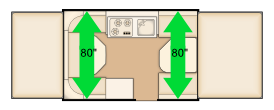
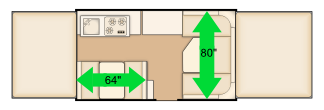
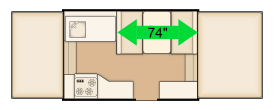
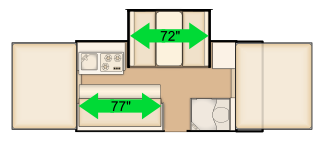
Are the 80" long dinettes better just because they're bigger? For sheer length, yes, but remember that dinettes oriented across the end of the camper block easy access to the bunk end; if the dinette table is in place people have to shimmy past the table to get to the bunk end. If the dinette is made into a bed, people have to crawl over the dinette bed to get to the end bed. So, depending on your preference a slightly shorter dinette/bed that offers a clear path to the end bed may work better while, for others, having a full-length bed is more important.
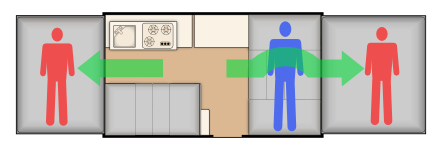
Sofa/Gaucho Location
In some models like the 228 and 228BHSE the sofa/gaucho sits across from the dinette. The benefit of this layout is the table leaf that comes with the dinette table. When in place the table leaf allows a fifth, sixth, or maybe even seventh person to sit at the dinette table for meals or game time.
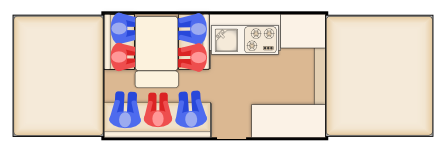
J-Dinette
The 206ST and 206STSE has what we call the "J-dinette"--a combination of a regular dinette and part of a wrap-around dinette. The "J" part of the dinette extends from the regular dinette to allow seating for a fifth--or maybe even sixth--person with a table leaf providing space for a plate or a cup (or a Scrabble letter-holder-thingy). This is a nice compromise that provides extra seating while not taking up the space a full second dinette would require.
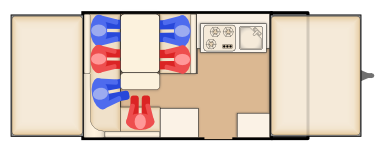
Wrap-Around Dinette
Wrap-around dinettes are interesting because they are either very beneficial or somewhat wasteful, depending on your needs. A wrap-around dinette is cozy and comfortable, especially if you're sitting in the "throne" position where the curved corner cushions hug your torso and you can put up your leg and relax.
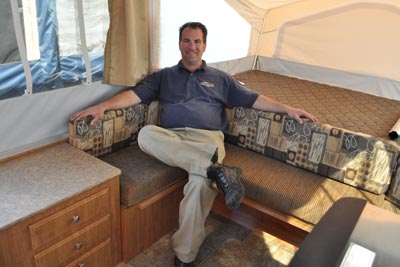
Dave in the corner "throne" seat
With some wrap-around dinettes, though, the extra cushion area needed to "wrap-around" the dinette is too shallow and that seat position is not usable to most adults (the 208 is the worst offender--though for kids or as a seat for two adults where each adult gets their own corner cushion the 208 wrap-around is rather nice).
The other thing to consider, especially when the wrap-around dinette is the only dinette in a camper, is leg-room and table size. Take two identically sized dinettes (like those in the High Wall slide-out units) and compare the regular dinette to the wrap-around dinette. At 50" wide, the regular dinette can sit six people if they don't mind rubbing shoulders a bit. Sitting six people at a wrap-around dinette (with an identical 50" width) forces the same number of people to share half the leg space and half the table surface area, as well as lose the space taken up by the corner cushions.
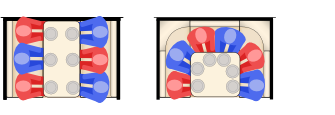
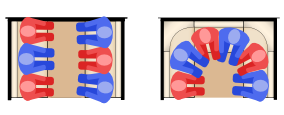
"So you're against wrap-around dinettes?" Not at all. They can be quite comfortable if you don't have a large group trying to crowd around them. Or, in the case of the 208, 227, and 823D, when a second dinette can be used as the main table area and the wrap-around dinette is only for a few people (or maybe used as the "kids' table") they are highly useful. Also, some people take out the wrap-around dinette table during the day and use that area for seating like a couch, not as a table. This has the added benefit of allowing people to sit down easily without having to scoot into a dinette with a table in place.
Free-Standing Table vs. Pedestal Table
This is largely a matter of personal preference. Some people want a table that can be moved around and even taken outside. Other people want the table secure in its designated spot. Still others don't have a preference so long as the table is big enough to do its job. For reference, all wrap-around dinettes are pedestal tables. Most regular dinettes have free-standing tables, some dinettes use a pedestal leg, and the front dinette on the 208 is rail-mounted (the end of the table attaches to the box of the camper and a flip-down leg holds the other end of the table up).
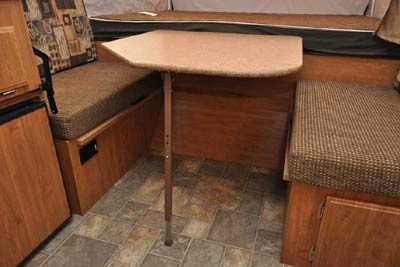
Rail-mounted table (with adjustable leg)
Special Note About Wheel Wells
Many models--like the 176LTD, 205, 207, 206ST, 227, 228, 228BH, 207SE, 206STSE, 228BHSE, T21DMHW, and T21FKHW--have part of their dinette's leg-room taken up by the wheel well. This is a necessary compromise for certain models in order to put the dinette where the layout demands. In some cases the wheel well cover is a minor intrusion but in three instances (176LTD, T21DMHW, and T21FKHW) the cover goes across the length of the dinette leg area rendering the dinette suitable for two adults only (and maybe two small children if they put their feet on the cover).
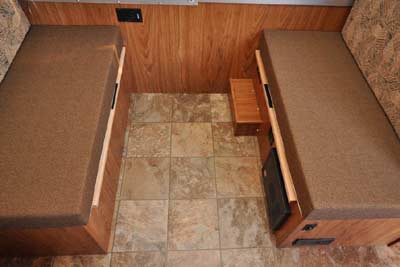
228 / 228BH / 228BHSE / 228BHSE with shower
Conclusion
Because there are many different dinette sizes and styles we recommend sitting at the dinette of any camper you're thinking about renting or buying. Keep in mind the pros and cons of where the dinette is located in the camper. Weigh the benefit of one dinette (and more counter space) vs. two dinettes (more seating).
Privacy © 2009-2024 Roberts Sales. All rights reserved.


